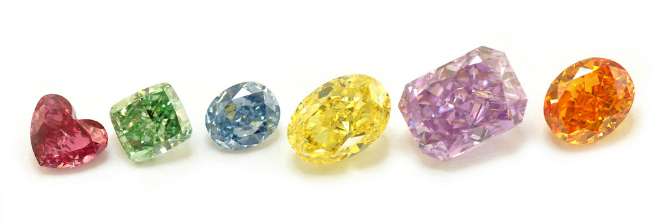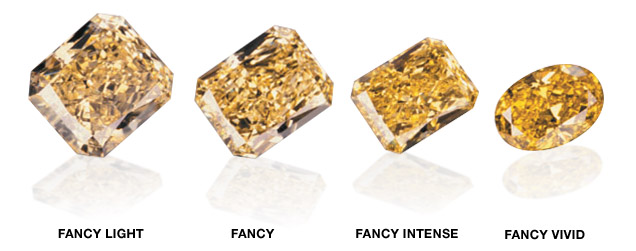Fancy Colour Diamonds
Exceptional diamond colour can be traced to the lattice of carbon atoms that form a diamond’s microscopic structure. Over billions of years, coloured diamonds were formed through exposure to heat, natural radiation or the saturation of natural elements. These incredibly rare processes result in beautiful tones and deep saturations of colour that evoke a deeply personal response in each of us.
Ideal diamonds are perfectly proportioned to refract light, producing that fire and brilliance up through to the table and crown. There are at least six “ideal cuts” being used today but only three of them (including the one by Tolkowsky ) are the most common.

Diamonds in the normal colour range are colourless through light yellow and are described using the industry’s D-to-Z colour-grading scale. Fancy colour diamonds, on the other hand, are yellow and brown diamonds that exhibit colour beyond the Z range, or diamonds that exhibit any other colour face-up. These rare specimens come in every colour of the spectrum, including, most importantly, blue, green, pink, and red.
Gem diamonds in the D-to-Z range usually decrease in value as the colour becomes more obvious. Just the opposite happens with fancy colour diamonds: Their value generally increases with the strength and purity of the colour. Large, vivid fancy colour diamonds are extremely rare and very valuable. However, many fancy diamond colours are muted rather than pure and strong.

Fancy Colour Diamond Quality Factors
Orange And Yellow Diamonds
The remarkable hue of yellow and orange diamonds can be attributed to one element: nitrogen. While a diamond is forming, nitrogen atoms will arrange in such a way that that blue light is absorbed, thus producing a yellow colour. A specific grouping of nitrogen atoms is also responsible for the shading of orange diamonds, but will absorb light in both the blue and yellow spectrums.


Brown, Red & Pink Diamonds
These diamonds owe their colour to a combination of intense pressure and heat. While still buried deep within the earth, these factors cause distortions in the crystal lattice that absorb green light, thus reflecting a pink hue. Ultra-rare red diamonds, which are essentially just deeply coloured pink diamonds, have the same cause of colour.
Gray & Blue Diamonds
For the most part, blue diamonds get their colour from boron. When this impurity is present, it bonds to carbon in the crystal structure, absorbing red, yellow and green areas of the colour spectrum.


Green Diamonds
It’s not until the last leg of their journey to the earth’s surface that diamonds get their green colour. Just as they are about to leave the uppermost layer of the crust, these stones absorbs naturally occurring radiation, which causes them to reflect a green hue by absorbing red and yellow light.
Violet And Purple Diamonds
So far, all scientists are certain of is that the cause of colour for purple and violet diamonds is crystal distortion. However, it is believed that the presence of hydrogen may be partly responsible for their hue.


